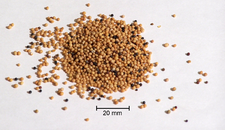- Mustard seed
-
mustard seed, yellow 
Nutritional value per 100 g (3.5 oz) Energy 1,964 kJ (469 kcal) Carbohydrates 34.94 g - Sugars 6.89 g - Dietary fiber 14.7 g Fat 28.76 g - saturated 1.46 g - monounsaturated 19.83 g - polyunsaturated 5.39 g Protein 24.94 g Water 6.86 g Vitamin A equiv. 3 μg (0%) Thiamine (vit. B1) 0.543 mg (47%) Riboflavin (vit. B2) 0.381 mg (32%) Niacin (vit. B3) 7.890 mg (53%) Vitamin B6 0.43 mg (33%) Folate (vit. B9) 76 μg (19%) Vitamin B12 0 μg (0%) Vitamin C 3 mg (4%) Vitamin E 2.89 mg (19%) Vitamin K 5.4 μg (5%) Calcium 521 mg (52%) Iron 9.98 mg (77%) Magnesium 298 mg (84%) Phosphorus 841 mg (120%) Potassium 682 mg (15%) Sodium 5 mg (0%) Zinc 5.7 mg (60%) Percentages are relative to US recommendations for adults.
Source: USDA Nutrient DatabaseMustard seeds are the small round seeds of various mustard plants. The seeds are usually about 1 or 2 mm in diameter. Mustard seeds may be colored from yellowish white to black. They are important spices in many regional foods. The seeds can come from three different plants: black mustard (Brassica nigra), brown Indian mustard (B. juncea), and white mustard (B. hirta/Sinapis alba).
Contents
History
The earliest reference to mustard is in India from a story of Gautama Siddhārtha (सिद्धार्थ गौतम) in the 5th century BCE. Gautama Buddha told the story of the grieving mother (Kisa Gotami) and the mustard seed. When a mother loses her only son, she takes his body to the Buddha to find a cure. The Buddha asks her to bring a handful of mustard seeds from a family that has never lost a child, husband, parent or friend. When the mother is unable to find such a house in her village, she realizes that death is common to all, and she cannot be selfish in her grief. [1] [2] The Buddha stated that if an individual were to pick a single mustard seed every hundred years from a seven-mile cube worth of mustard seeds, then by the time the last seed is picked, the age of the world cycle would still continue. (If a mustard seed is 3 mm in diameter, then taking one seed every 100 years from a seven-mile cube of seeds, would take 936 quintillion years, 68 billion times the age of the universe.)[3]
The French have used mustard seeds as a spice since 800 AD, and it was among the spices taken by the Spanish on explorations throughout the fifteenth century.
In the Quran, it is stated that the scales of justice will be established on the Day of Judgement, and no soul will suffer the least injustice. Even the equivalent of a mustard seed will be accounted for because God is the most efficient reckoner.[4]
Jewish texts compare the knowable universe to the size of a mustard seed to demonstrate the world's insignificance and to teach humility. [5] The Jewish philosopher, Nahmanides, mentions the universe expanded from the time of its creation, in which it was the size of a mustard seed.[6]
In the Christian New Testament, the mustard seed is used by Jesus in the parable of the Mustard Seed as a model for the kingdom of God which initially starts small but grows to be the biggest of all garden plants. Faith is also spoken about in the context of a mustard seed.[7][8][9][10][11]
Regional usage
Aavalu (Telugu: ఆవlu), kadugu (Tamil: கடுகு), or sasive (Kannada:ಸಾಸಿವೆ), a variety of Indian pickle consisting mainly of mangoes, red chilli powder and aavaa pindi (powdered mustard seed) preserved in mustard oil, is popular in South India with its origin in Andhra Pradesh.
These mustard seeds are known in Hindi/Urdu as sarson and in Punjabi as sarron. These are used as a spice in North India and Nepal. The seeds are usually roasted until they pop. They are also planted to grow saag (greens) which are stir-fried and eaten as a vegetable preparation, sarson ka saag (sarron da saag in Punjabi).
In Maharastra, it is called as mohari, and is used frequently in Maharastrian recipes.
Sarson ka tel (mustard oil) is used for body massage during extreme winters, as it is assumed to keep the body warm and moist.
Cultivation
Mustard seeds generally take three to ten days to germinate if placed under the proper conditions, which include a cold atmosphere and relatively moist soil. Mature mustard plants grow into shrubs.
Mustard grows well in temperate regions. Major producers of mustard seeds include Canada (90%), Hungary, Great Britain, India, Pakistan and the United States. Brown and black mustard seeds return higher yields than their yellow counterparts.[12]
In Pakistan, rapeseed-mustard is the second most important source of oil, after cotton. It is cultivated over an area of 307,000 hectares with annual production of 233,000 tonnes and contributes about 17% to the domestic production of edible oil.
Mustard seed is a rich source of oil and protein. The seed has oil as high as 46-48 percent, whole seed meal has 43.6 percent protein.
See also
References
- ^ Sharman, Shreshtha, Neeta Sharma - Together with English Language & Literature (Term II)(page 222) retrieved 2011-11-06
- ^ Buddhaghosa - Buddhist legends, Volume 28 ( published 1921) retrieved 2011-11-06
- ^ "Sasapa Sutta - Wikipitaka - The Completing Tipitaka". Tipitaka.wikia.com. 2008-12-04. http://tipitaka.wikia.com/wiki/Sasapa_Sutta. Retrieved 2010-07-28.
- ^ "The Authorized English Translation of the Quran, Sura - 21 The Prophets (Al-Anbya'), translated from the original by Dr. Rashad Khalifa, Ph.D". Submission.org. http://www.submission.org/suras/sura21.html. Retrieved 2010-07-28.
- ^ Jay Michaelson - learnkabbalah.com also verification at about jay michaelson
- ^ Dr.Gerald Schroeder - © 2011 Aish.com - Your Life, Your Judaism
- ^ Matthew 13:31–13:32
- ^ Matthew 17:20–17:21
- ^ Mark 4:30–4:32
- ^ Luke 13:18–13:19
- ^ Luke 17:6
- ^ "Pulses and Special Crops > Pulses and Special Crops > Producers". Agr.gc.ca. 2007-03-20. http://www.agr.gc.ca/misb/spec/index_e.php?s1=mtd&page=intro. Retrieved 2010-07-28.
External links
Categories:- Spices
- Edible nuts and seeds
Wikimedia Foundation. 2010.
